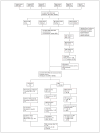Genetic variation and neuroimaging measures in Alzheimer disease
- PMID: 20558387
- PMCID: PMC2956757
- DOI: 10.1001/archneurol.2010.108
Genetic variation and neuroimaging measures in Alzheimer disease
Abstract
Objective: To investigate whether genome-wide association study (GWAS)-validated and GWAS-promising candidate loci influence magnetic resonance imaging measures and clinical Alzheimer's disease (AD) status.
Design: Multicenter case-control study of genetic and neuroimaging data from the Alzheimer's Disease Neuroimaging Initiative.
Setting: Multicenter GWAS. Patients A total of 168 individuals with probable AD, 357 with mild cognitive impairment, and 215 cognitively normal control individuals recruited from more than 50 Alzheimer's Disease Neuroimaging Initiative centers in the United States and Canada. All study participants had APOE and genome-wide genetic data available.
Main outcome measures: We investigated the influence of GWAS-validated and GWAS-promising novel AD loci on hippocampal volume, amygdala volume, white matter lesion volume, entorhinal cortex thickness, parahippocampal gyrus thickness, and temporal pole cortex thickness.
Results: Markers at the APOE locus were associated with all phenotypes except white matter lesion volume (all false discovery rate-corrected P values < .001). Novel and established AD loci identified by prior GWASs showed a significant cumulative score-based effect (false discovery rate P = .04) on all analyzed neuroimaging measures. The GWAS-validated variants at the CR1 and PICALM loci and markers at 2 novel loci (BIN1 and CNTN5) showed association with multiple magnetic resonance imaging characteristics (false discovery rate P < .05).
Conclusions: Loci associated with AD also influence neuroimaging correlates of this disease. Furthermore, neuroimaging analysis identified 2 additional loci of high interest for further study.
Figures

Comment in
-
Identification of Alzheimer risk factors through whole-genome analysis.Arch Neurol. 2010 Jun;67(6):663-4. doi: 10.1001/archneurol.2010.97. Arch Neurol. 2010. PMID: 20558384 No abstract available.
Similar articles
-
Genome-wide association of familial late-onset Alzheimer's disease replicates BIN1 and CLU and nominates CUGBP2 in interaction with APOE.PLoS Genet. 2011 Feb;7(2):e1001308. doi: 10.1371/journal.pgen.1001308. Epub 2011 Feb 17. PLoS Genet. 2011. PMID: 21379329 Free PMC article.
-
Meta-analysis for genome-wide association study identifies multiple variants at the BIN1 locus associated with late-onset Alzheimer's disease.PLoS One. 2011 Feb 24;6(2):e16616. doi: 10.1371/journal.pone.0016616. PLoS One. 2011. PMID: 21390209 Free PMC article.
-
Potential contribution of the Alzheimer's disease risk locus BIN1 to episodic memory performance in cognitively normal Type 2 diabetes elderly.Eur Neuropsychopharmacol. 2016 Apr;26(4):787-95. doi: 10.1016/j.euroneuro.2015.11.004. Epub 2015 Nov 14. Eur Neuropsychopharmacol. 2016. PMID: 26947052 Free PMC article.
-
Genetic evidence for the involvement of lipid metabolism in Alzheimer's disease.Biochim Biophys Acta. 2010 Aug;1801(8):754-61. doi: 10.1016/j.bbalip.2010.04.005. Epub 2010 Apr 24. Biochim Biophys Acta. 2010. PMID: 20420935 Review.
-
Genetics of Alzheimer's disease: new evidences for an old hypothesis?Curr Opin Genet Dev. 2011 Jun;21(3):295-301. doi: 10.1016/j.gde.2011.02.002. Epub 2011 Mar 1. Curr Opin Genet Dev. 2011. PMID: 21371880 Review.
Cited by
-
A genome-wide association study of brain lesion distribution in multiple sclerosis.Brain. 2013 Apr;136(Pt 4):1012-24. doi: 10.1093/brain/aws363. Epub 2013 Feb 13. Brain. 2013. PMID: 23412934 Free PMC article.
-
A large scale multivariate parallel ICA method reveals novel imaging-genetic relationships for Alzheimer's disease in the ADNI cohort.Neuroimage. 2012 Apr 15;60(3):1608-21. doi: 10.1016/j.neuroimage.2011.12.076. Epub 2012 Jan 8. Neuroimage. 2012. PMID: 22245343 Free PMC article.
-
A Polygenic Risk Score Derived From Episodic Memory Weighted Genetic Variants Is Associated With Cognitive Decline in Preclinical Alzheimer's Disease.Front Aging Neurosci. 2018 Dec 19;10:423. doi: 10.3389/fnagi.2018.00423. eCollection 2018. Front Aging Neurosci. 2018. PMID: 30620773 Free PMC article.
-
Genetic analysis of cortical thickness and fractional anisotropy of water diffusion in the brain.Front Neurosci. 2011 Oct 19;5:120. doi: 10.3389/fnins.2011.00120. eCollection 2011. Front Neurosci. 2011. PMID: 22028680 Free PMC article.
-
Structural Neuroimaging Genetics Interactions in Alzheimer's Disease.J Alzheimers Dis. 2015;48(4):1051-63. doi: 10.3233/JAD-150335. J Alzheimers Dis. 2015. PMID: 26444770 Free PMC article.
References
-
- Alzheimer’s Association. 2009 Alzheimer’s disease facts and figures. Alzheimers Dement. 2009;5(3):234–270. - PubMed
-
- Lambert J-C, Heath S, Even G, et al. European Alzheimer’s Disease Initiative Investigators. Genome-wide association study identifies variants at CLU and CR1 associated with Alzheimer’s disease. Nat Genet. 2009;41(10):1094–1099. - PubMed
Publication types
MeSH terms
Substances
Grants and funding
- P50 AG05681/AG/NIA NIH HHS/United States
- R01 AG026484/AG/NIA NIH HHS/United States
- U24 AG021886/AG/NIA NIH HHS/United States
- R01 EB001550/EB/NIBIB NIH HHS/United States
- AG021910/AG/NIA NIH HHS/United States
- K01AG030514/AG/NIA NIH HHS/United States
- R01 NS042861/NS/NINDS NIH HHS/United States
- R01 NS059727/NS/NINDS NIH HHS/United States
- R01 AG021910/AG/NIA NIH HHS/United States
- R21 DA026104/DA/NIDA NIH HHS/United States
- R01 EB006758/EB/NIBIB NIH HHS/United States
- U54 RR020278/RR/NCRR NIH HHS/United States
- K01 AG030514/AG/NIA NIH HHS/United States
- U24 RR021382/RR/NCRR NIH HHS/United States
- U01 AG024904-01/AG/NIA NIH HHS/United States
- P41-RR14075/RR/NCRR NIH HHS/United States
- R01 RR 16594-01A1/RR/NCRR NIH HHS/United States
- P30 AG010129-19/AG/NIA NIH HHS/United States
- R01 EB006758-04/EB/NIBIB NIH HHS/United States
- R01 NS052585-01/NS/NINDS NIH HHS/United States
- K01 AG030514-04/AG/NIA NIH HHS/United States
- U01 AG024904/AG/NIA NIH HHS/United States
- AG02238/AG/NIA NIH HHS/United States
- U19 AG010483/AG/NIA NIH HHS/United States
- HHMI/Howard Hughes Medical Institute/United States
- P01 AG003991/AG/NIA NIH HHS/United States
- P50 AG005681/AG/NIA NIH HHS/United States
- P41 RR014075-12/RR/NCRR NIH HHS/United States
- P41 RR014075/RR/NCRR NIH HHS/United States
- P01AG03991/AG/NIA NIH HHS/United States
- R01 NS052585/NS/NINDS NIH HHS/United States
- R01 RR016594/RR/NCRR NIH HHS/United States
- P30 AG010129/AG/NIA NIH HHS/United States
- R01 NS052585-01A1/NS/NINDS NIH HHS/United States
- P30 AG010129-20/AG/NIA NIH HHS/United States
LinkOut - more resources
Full Text Sources
Medical
Miscellaneous

